Japan’s attack on Hong Kong was the first fight of the war for Canadian soldiers. It didn’t end well.
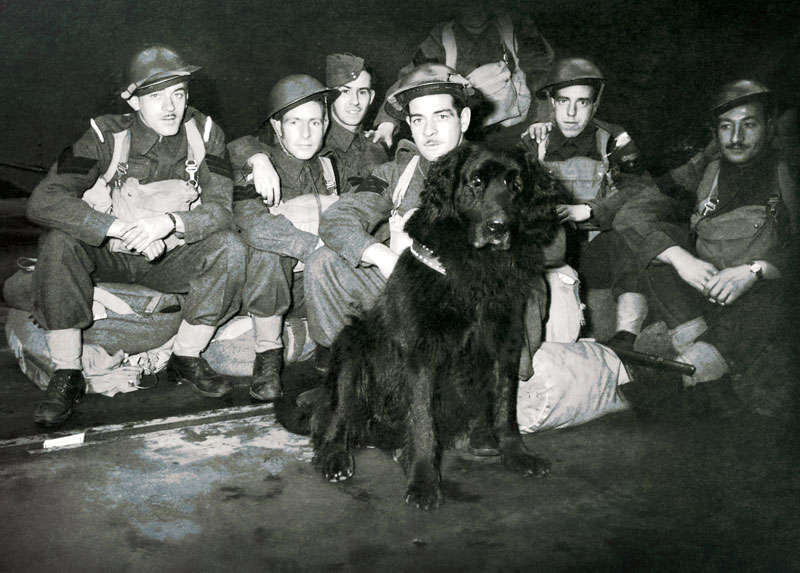
Infantrymen of ‘C’ Company, Royal Rifles of Canada, and their mascot about to embark for Hong Kong from Vancouver on Oct. 27, 1941. [LAC/3241498]
“It was a grand day…. Our two battalions marched down Nathan Road steel-helmeted and obviously invincible. The main street of Kowloon was lined by cheering crowds waving small Union Jacks.”
Eighteen-year-old Rifleman Ken Cambon was excited by the joyous reception the Canadian contingent received in Hong Kong on Nov. 16, 1941. Describing his barracks, he noted, “We were astounded by the luxury of the camp after eighteen months of Canadian Army life.”
Even “lowly” privates had orderlies who delivered tea in bed each morning, shined shoes, pressed uniforms, made beds and even offered shaves. Less than six weeks later, the genteel luxury was literally blown away.
What were Canadian Army units doing in such a faraway outpost of the British Empire? Suffice to say it was an ill-advised response to a request by Britain, which had already decided not to commit more of its own forces to the Crown colony, based on various assessments that showed it would be challenging to defend Hong Kong.
Even British Prime Minister Winston Churchill believed that the colony could not be held or relieved in the event of war with Japan.
Although this conclusion apparently was never passed to Canadian authorities, the British formally requested additional soldiers from the Canadian government in mid-September. Ottawa concurred and the fate of 1,975 Canadians was decided.
On Oct. 27, 1941, 1,875 Canadians boarded the recently converted troopship Awatea. They included brigade headquarters staff, the Royal Rifles of Canada, the Winnipeg Grenadiers, a 100-man reinforcement company for each battalion, plus signals, medical, dental, service corps, ordnance, provost and postal detachments.
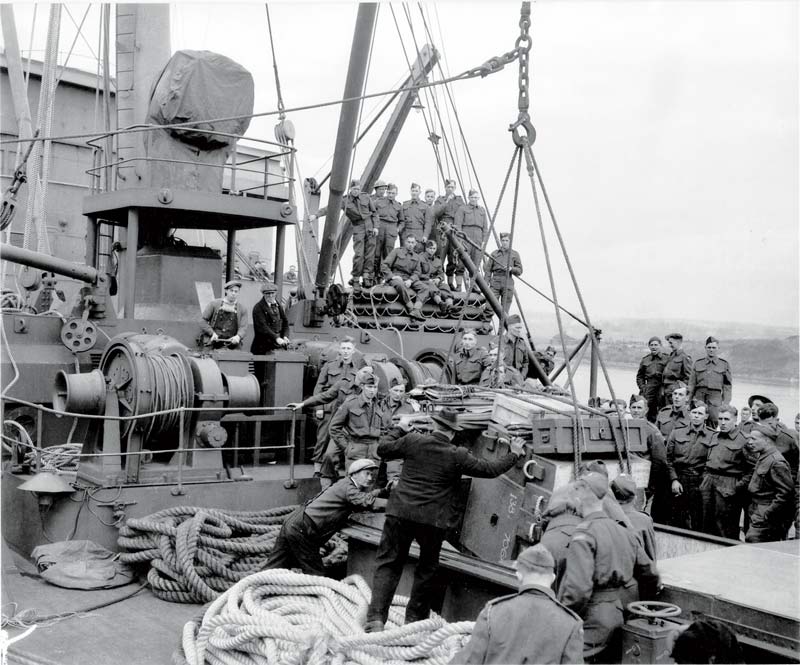
Longshoremen load military equipment and supplies aboard HMT Awatea in Vancouver shortly before departure. [LAC/PA-116789]
Among the medical staff were nursing sisters Lieutenant Kay Christie and Lieutenant May Waters. They became the first and only Canadian nursing sisters ever captured in war. Lack of available space sent another 100 Canadians on Awatea’s escort, the armed merchant cruiser HMCS Prince Robert.
The uneventful 21-day crossing via Honolulu and Manila to Hong Kong was not improved by the food. The succinct assessment by Grenadier Gordon Durant, 19, of the monotonous diet was “Nuttin’ but mutton!”
‘C’ Force, as the Canadian contingent was designated, arrived in Hong Kong on Nov. 16. It was commanded by newly promoted Brigadier John Lawson, a First World War veteran. The two battalions had previously served on garrison duty. The Royal Rifles, a bilingual Quebec City unit (although 246 of its soldiers were Maritimers), were stationed in Newfoundland, while the Grenadiers served in Jamaica.
Vehicles, machine guns, mortars and ammunition belonging to the two battalions were shipped later in an American cargo ship, only to be diverted to the Philippines. The Hong Kong garrison, commanded by Major-General Christopher Maltby, now numbered roughly 14,000 defenders, made up of British, Canadian and Indian troops, augmented by local volunteers.
They were supported by three old Royal Navy destroyers, as well as four gunboats and eight motor torpedo boats. The Royal Air Force provided five obsolete aircraft.
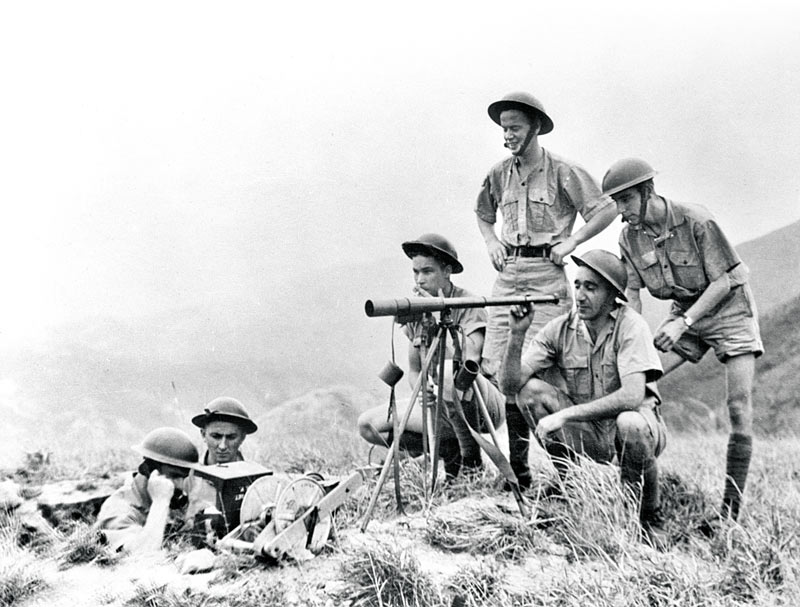
Canadian army signallers man a position in the hills overlooking Hong Kong. [Australian War Memorial/010796]
Hong Kong consists of three regions: the island proper, the city of Kowloon and surroundings on the mainland peninsula, and the New Territories to the north. A channel only 500 metres wide in some places separates the island from the mainland.
Maltby defended forward and divided his six battalions into two brigades. British Brigadier Cedric Wallis commanded the Mainland Brigade, while Lawson commanded the Island Brigade. The only Canadian unit in the Mainland Brigade was the signals section.
Wallis sited his three battalions along the quaintly named Gin Drinkers’ Line (after a local bay). Its fortified positions stretched for some 18 kilometres through rugged, hilly terrain. Lawson concentrated his troops on the south side of the island to defend against a potential invasion from the sea—an attack that never came.
Combat-hardened Japanese soldiers advanced against the Gin Drinkers’ Line.
Without warning, the Japanese attacked Pearl Harbor in Hawaii on the morning of Dec. 7 (Dec. 8 in Hong Kong because of the International Date Line). This was followed shortly by attacks on northern British Malaya, the Philippines, Guam, Wake Island—and Hong Kong.
Japanese aircraft bombed and strafed the airfield, destroying or damaging all British airplanes. The Royal Navy quickly ordered two of its three destroyers to the safety of Singapore, more than 2,000 kilometres away.
At the same time, combat-hardened Japanese soldiers advanced against the Gin Drinkers’ Line. On the night of Dec. 9-10, they captured the Shing Mun Redoubt, which was the key position on the line.

The first contingent of 1,975 soldiers from the Royal Rifles of Canada and Winnipeg Grenadiers arrive in Hong Kong on Nov. 16, 1941. [LAC/C-049744]
‘D’ Company of the Grenadiers was sent to the mainland in darkness to reinforce this sector, arriving at 4 a.m. on Dec. 10. When the Winnipeggers engaged Japanese scouts about mid-afternoon later that day, they became the first Canadian soldiers to fight in the Second World War.
Japanese forces broke through the Gin Drinkers’ Line on Dec. 11. Advancing toward Kowloon, they forced Allied units back under heavy artillery and aerial bombardment. When Kowloon fell on Dec. 13, the survivors retreated to Hong Kong Island under cover of ‘D’ Company.
The Japanese paused before the next phase, a nighttime amphibious assault against the island. Meanwhile, they took the opportunity to soften up British defences by bombarding relentlessly with artillery and aircraft.
Maltby reorganized his units again. The West Brigade under Lawson contained the Grenadiers, while the East Brigade included the Royal Rifles.
The Japanese were helped by a large and active fifth column operating on the island. They located fixed gun positions and troop concentrations and flashed the information across the channel to the Japanese. The fifth columnists also disseminated alarmist propaganda and false rumours to the civilian population.
On the evening of Dec. 18, three fresh Japanese regiments in small boats crossed the narrow waterway separating the mainland from the island. The battle-wise Japanese pushed ashore at several locations and quickly overwhelmed most of the Allied defences they encountered.
He and his men were going outside to fight it out “rather than be killed like rats.”
The Japanese fanned out, forcing the defenders to withdraw into the mountains to the south. All combat is chaotic, but from this point forward, the battle became extremely confused and broke down into small and frequently badly organized actions.
As enemy soldiers approached the summit of Mount Butler during the early hours of Dec. 19, Lawson ordered ‘A’ Company of the Grenadiers to attack them. The Canadians captured the peak in a bayonet charge and stayed there for three hours before being forced to withdraw.
Later that day, the invaders overwhelmed Lawson’s West Brigade headquarters. When it was about to be overrun, he telephoned Maltby and told him he and his men were going outside to fight it out “rather than be killed like rats.”
Lawson and his headquarters group did not make it very far. Machine-gun fire cut them to pieces as they charged the encircling enemy. Lawson died eight days before his 55th birthday. He was the first and highest ranking Canadian commander killed in action during the war. His undertrained Canadian units, along with British and Indian regulars and Hong Kong volunteers, managed to hold out for a bit longer.
On Dec. 22, the Japanese split the island in two by capturing a strategic gap through which a main north-south road ran. British Empire forces were reduced to the southeastern end of the island around the Stanley Peninsula, plus the western end.
Several days and nights of heavy fighting followed. The Allies fought bravely and managed to mount a few counterattacks, but the Japanese maintained their pressure and relentlessly forced Empire troops back. It all came down to the greater numbers, immediate reinforcements, air superiority and battle experience of the Japanese.
Sergeant George MacDonell commanded a platoon in the Rifles’ ‘D’ Company which had been ordered to counterattack a ridge above the village of Stanley on Christmas morning. Outnumbered and with no artillery support, the company was wiped out in the fruitless attack. Afterward, MacDonell was “haunted by the tragic and unnecessary loss of those young lives.”
They were imprisoned in Hong Kong in revolting conditions.
The defenders surrendered that afternoon, after nearly 18 days of non-stop battle. They were out of water and split into small pockets of resistance. Among the Canadians, 290 had been killed in action and a further 493 wounded.
Victorious Japanese soldiers immediately went on a killing orgy, bayoneting, mutilating or shooting prisoners, medical staff and the badly wounded in hospitals and first-aid posts. Their interpretation of the Japanese warrior code held that a soldier who surrendered was no longer a soldier—or even a human being—and deserved savage contempt. Even noncombatants weren’t safe: British and Chinese nurses were gang raped and several were bayonetted.
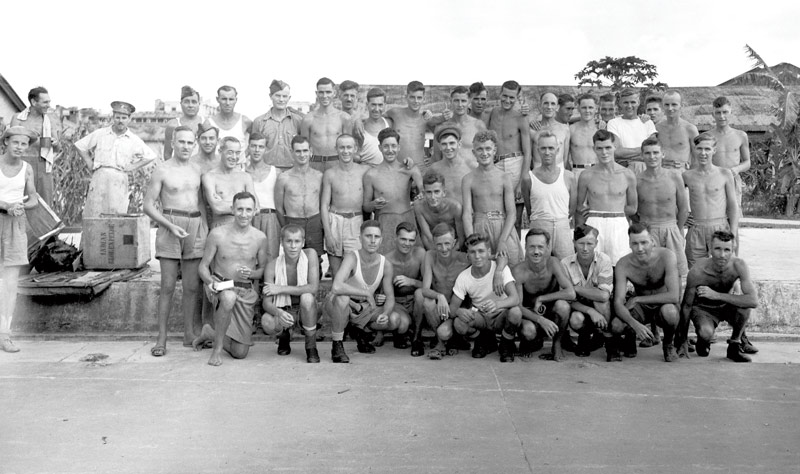
Canadian and British prisoners of war are pictured at Kowloon after their August 1945 liberation by rescuers deployed from HMCS Prince Robert. [Jack Hawes/LAC/3227339]
For 1,685 Canadian survivors, the horrifying ordeal had just begun. They were imprisoned in Hong Kong in revolting conditions until early 1943, when 1,184 were sent to Japan.
In Japan, Canadian soldiers were used as slave labour in dockyards or coal and iron mines. Whether in Hong Kong or Japan, all prisoners were treated harshly and suffered subhuman treatment. They were housed in crude huts overrun by rodents and bugs, suffered abuse from their guards, became weak and malnourished from a starvation diet, and contracted many diseases, usually without any medicines to treat them.
This living hell dragged on for three years and eight months of cruelty, pain, sickness and degradation. At the end of the war, when the gaunt Canadian PoWs were liberated, there were 264 fewer of them, largely the result of harsh treatment by the Japanese. This included four executed on the spot for trying to escape.
Other Canadians had been executed for various “crimes,” while some were beaten to death on the whim of a guard. The results of their cruel imprisonment continued to plague the survivors after the war. Their average life expectancy was 10 years less than other Canadian veterans of the Second World War, the result of their brutal treatment. Most never forgave their captors.
MacDonell believed that “no one who survived…escaped the emotional and physical trauma of the Battle of Hong Kong and the starvation, malnutrition, slave labour, anxiety and humiliation suffered in Japanese prison camps.”
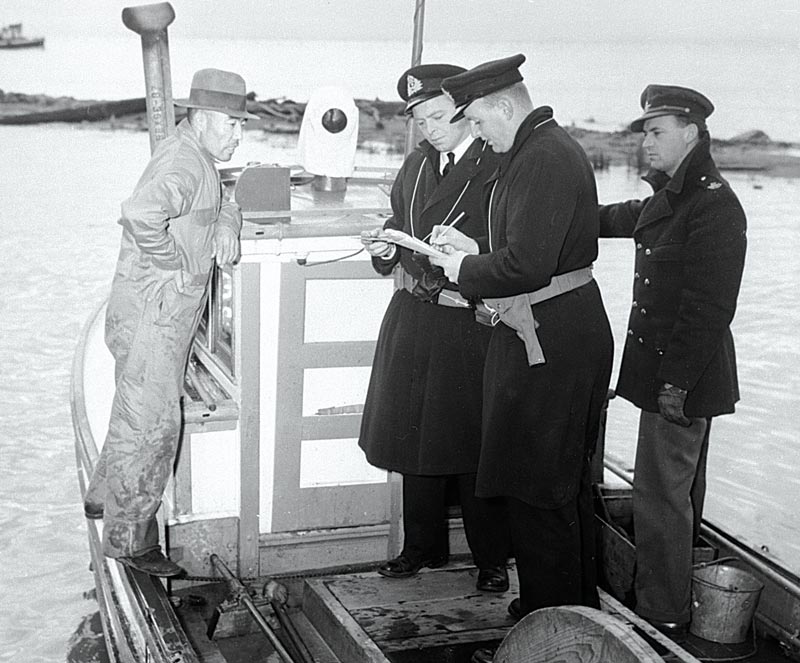
A Canadian naval officer questions a Japanese-Canadian fisherman while confiscating his boat at Esquimalt, B.C. Some 27,000 persons of Japanese origin were detained by the federal government after the fall of Hong Kong. [LAC/3519867]
The reasons so many Canadians were committed to what was already a lost cause at the request of the British remains a hotly debated topic today.
Even the Official History of the Canadian Army in the Second World War by respected historian Colonel C.P. Stacy notes, “We can see today that the decision to reinforce Hong Kong was a mistake.”
After the fall of Hong Kong, public pressure led the federal government to order male Japanese nationals between 18 and 45 away from the British Columbia coast in January 1942. This was followed by the detainment of some 27,000 persons of Japanese origin. Families were moved to rudimentary camps inland for the rest of the war. Their property was seized and sold at rock-bottom prices. Some were deported.
No campaign medal was awarded for service in Hong Kong. But after years of agitation by veterans of the defeat, the Hong Kong Bar was finally approved in 1994, to be worn on the ribbon of the Canadian Volunteer Service Medal.
It was small recognition to honour the soldiers who died or were captured in the Canadian Army’s futile first battle of the Second World War.
—
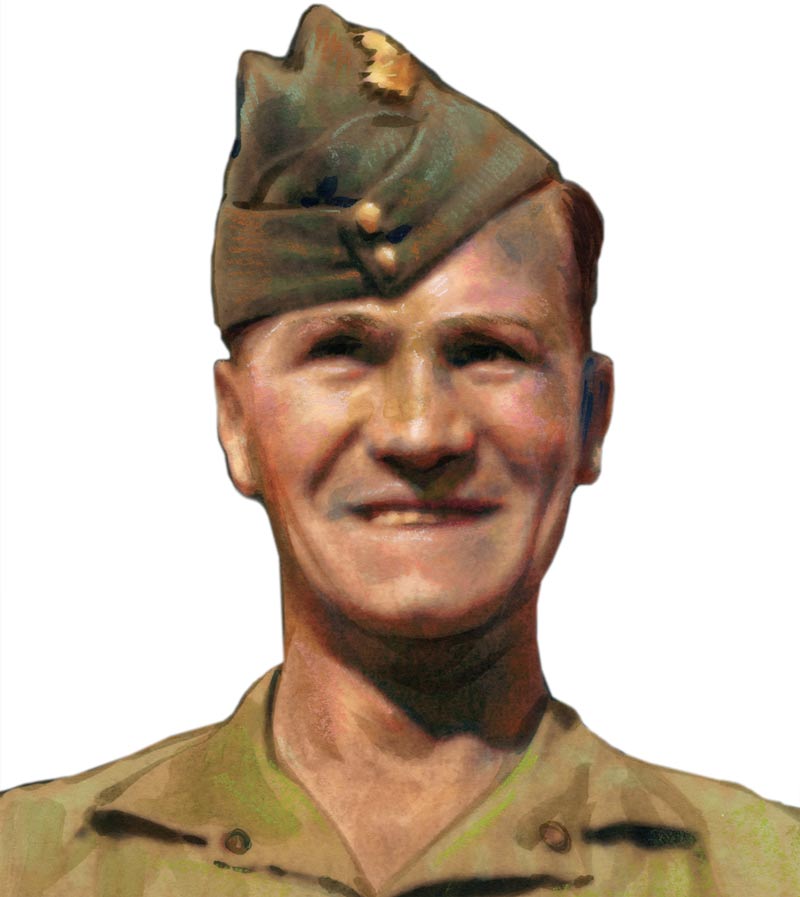
Company Sergeant Major John Osborn. [Sharif Tarabay]
Company Sergeant Major John Osborn, 42, commanded some of the Winnipeg Grenadiers ordered to capture the summit of Mount Butler. When later forced to pull back, Osborn gave his life for his comrades when he threw himself on a grenade, yelling, “Duck lads!”
His selfless act saved the lives of six or seven soldiers. Osborn was awarded the Victoria Cross. His deed was the first to occur chronologically during the war, but it did not become known until surviving Canadians were released at the end of the war, making it the last to be awarded.
Advertisement






















